The Serengeti holds lots of meaning for me; it featured in Willard Price’s books about Hal & Roger Hunt which I read when I was young; it is also famous as one of the world’s great wildlife areas, and the concept of Serengeti has even become part of English language to describe something rich and buzzing with life; it’s known for the endless herds and the dramatic river crossings that draw in over 300,000 visitors per year, and, not least, I was due to travel there in 2004 but fell sick and missed the chance! But there’s more to it; when I moved to Zambia, I found a diverse, wooded savannah, rich in life and short on visitors. To a great extent, Zambia (and the South Luangwa in particular) offered the opposite experience to the Great Plains of Serengeti – private, serene experiences with Nature and the luxury of feeling that you had the place to yourself. So many times, I would hear, “if this was in the Serengeti, there would be X number of vehicles around this lion”.
I was therefore very excited to chat with return guests about visiting some areas of the Serengeti ecosystem in the Green Season – a time when the herds and the visitors have moved on but the park’s vast grandeur is available to those who are willing to dodge the occasional rain storms. Unlike the river valleys of southern Africa, which become very inaccessible in the rainy months, the high altitude grassland of the Serengeti remains (mostly) navigable during the wetter months. If you’re willing to accept the absence of the massive herds, much of the remaining wildlife is present and visible, offering a special window into Africa’s most famous reserve.
As always, what follows is a caption-based report of our trip. You can find more, including a lot of video content, on my Instagram page in the highlights section. I have saved the stories from this trip on my profile page. Thank you for reading.

We started the trip in the Ndutu Conservation Area which adjoins the Serengeti on the southern side. It’s a mix of lakes, riparian woodland, thickets, marshes and open plains beyond. There is the full range of wildlife, including beautiful Greater and Lesser Flamingos in the shallows of Lake Ndutu.

On our first evening, before even reaching the camp, we found a lioness up a tree, avoiding the flies and scouting for prey. From her behaviour, it seemed that she had cubs hidden somewhere nearby.

The following morning we scouted the drainage channels that lead into Lake Ndutu hoping to find lions on the hunt. We found one female who had lost a cub the day before and she was searching for it… Is was hard to watch, though the remaining cub was still intent on lifting Mum’s mood.

Emerging on to the open plains, we scouted regularly for cheetah and enjoyed the herds of wildebeest and eland scattered across the grassland. Kori bustard were plentiful and apparently didn’t mind us approaching them closely while they engaged in their territorial displays.

Morning 1 and our first cheetah hunt. We followed her for a long time, giving her space and hoping she would chase some of the many Thompson’s gazelles; she did and we watched a fantastic hunt, but the action moved away from us and we were not able to photograph it!

Near Asilia’s Olakira Migration camp where we were staying lives a highly habituated Caracal. We spent a long time looking for it and eventually tracked her down one afternoon; she was hunting and caught several mice while we watched.

When you get a calm caracal, you maximise the opportunities, so we spent the whole afternoon with her, culminating in this beautiful moment when she sat and stared back at us.
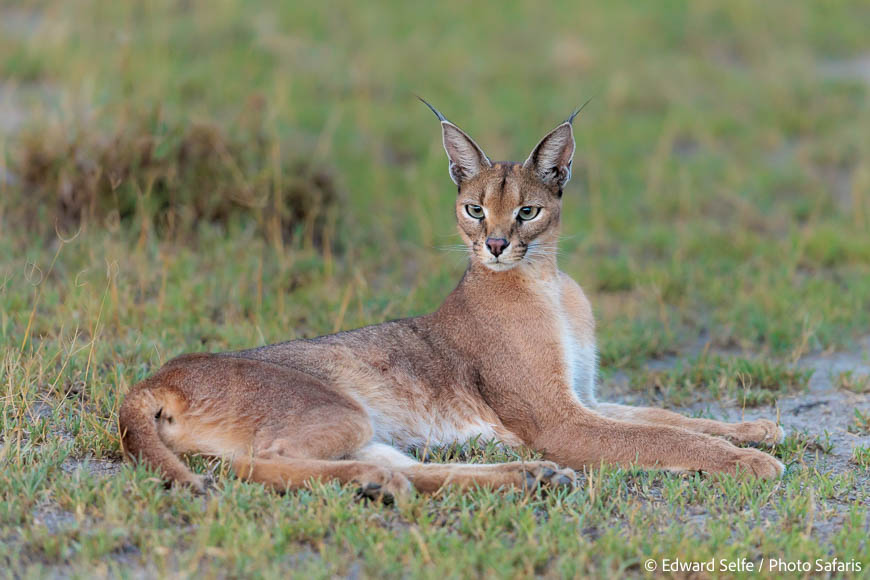

Early the next day, out on the plains, a group of 3 male lions were patrolling in the open. They appeared to have a mission but we never discovered it as the heat of the morning overtook them and they crashed out in a thicket!

The addition of the flowers at this time of year is a welcome point of interest and more striking than the dull browns of dry season.

Another day, another cheetah. This one was very alert and vigilant but apparently not keen to hunt. We observed him scouting for many promising options but then he abandoned the plan and moved off. (Using the camera’s rear screen, I took this shot by lowering the camera over the side of the vehicle and relying on the excellent eye-detect AF to lock on to the subject.)
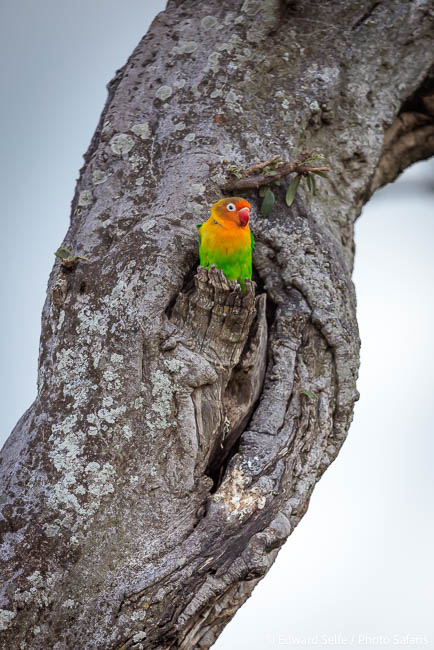
Ndutu’s birdlife is phenomenal; everywhere we drove, the bush around us was lifting with life – cuckoos of all descriptions, weavers, sunbirds, silverbirds, raptors and the most colourful of all, the Fischer’s love birds.

Giraffes made more beautiful by the carpets of Bidens flowers along the waterways.

There is something magically exotic about flamingos; sitting on the edge of the lake we enjoyed dawn with them one day while listening for sounds of the bush around us.
After 3 nights in Ndutu, we moved to Namiri Plains in the eastern part of the Serengeti Plains for 7 nights. This area is characterised by large open plains, punctuated with rocky outcrops. Along the Ngare Nanyuki river that passes in front of the camp, riverine forests, including this fever tree forest, offer great habitat for cats and especially the sought-after serval.

Due to the excellent rains since November, the area was full of elephants, apparently uncommon for this time.
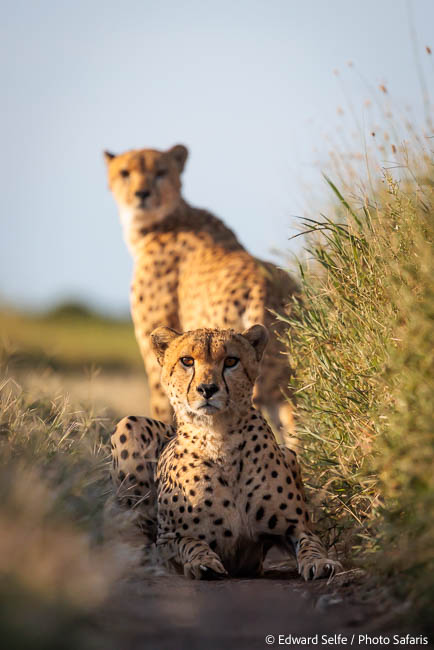
The first afternoon gave us a trio of cheetah brothers who put on an amazing show. Initially they rested in the road during the heat of the afternoon…..(using my low-level shooting technique once more)…

…but then they rose and started to move towards a large rock which we hoped would act as a lookout for them….

As if planned, they walked to it and just in time to reflect the pink light of the developing sunset!

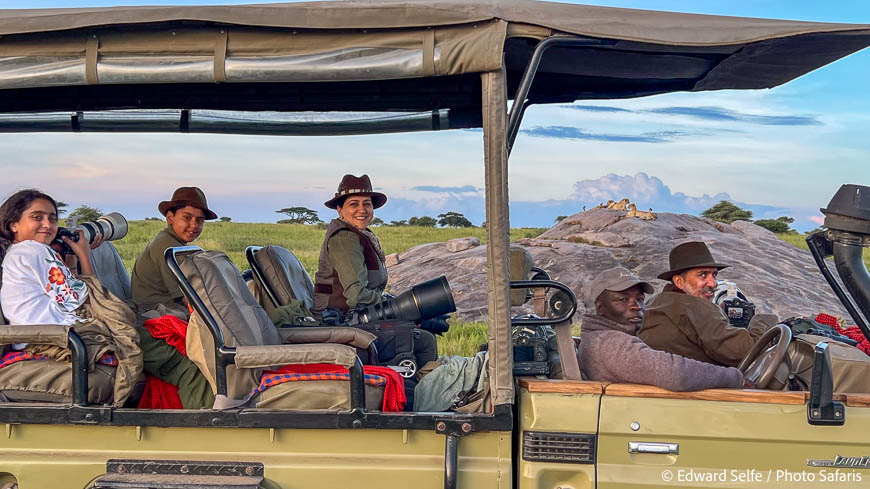
Happy people watching cheetahs!

The kopjes offer great opportunities for silhouettes after sunset.

Early the next day, we took a speedy drive to Gol Kopjes, hoping to find the lions on the rocks in the early morning. Indeed they were, seeking refuge from a pair of feisty bull buffalos that were feeding at the base. Given the abundance of game on the plains, and the formidable nature of buffalo, lions tend to focus their attentions on smaller and easier targets! Spot the second lioness on the rock?

The males were sadly not on the rocks, though this handsome chap was impressive with his windswept mane.

Later that morning, we found a cheetah with her well-grown cub. She was certainly hunting but her ambitions did not stretch to a chase.

In fact we, and the other guides from camp, spent a fair bit of time with her over the week and she didn’t seem to have any luck hunting.

The next day, another cheetah, this time a male in the Semetu – Cub Valley area. He was alert and observant, but the arrival of 6 lions meant that he had to move on and search for a new hunting area!

Our first major storm arrived that afternoon. The skies were spectacular and we enjoyed it for as long as we could before rolling down the flaps and turning our back to the rain!

On a freshly-washed morning, we were out early once more, enjoying the sunrise light and scenery.


The cheetah sightings came thick and fast, this time two siblings that we spent time with before they settled in the grass. During the trip, we saw more than 20 cheetah but, apart from day 1, none of them were in true hunting mode. We discussed this at length, wondering why that was the case, and concluded that it was just the luck of the draw. Such is wildlife sometimes, and I expect that on another day, things would be different!


The stormy skies in the west during the afternoon created stunning scenes, and led to one of the most beautiful sightings of the trip….

Late one afternoon, we found a pair of lions. They were clearly courting but the female was unsure of the situation and continually repelled the male. He was very attentive, not letting her more than a few meters from his side.

The patterns in the water, which reflected the dark skies above, made for an interesting and unusual scene.


At one stage, the male’s advances were too strong, and the female turned and swiped at him. She made contact, but her claws were perhaps retracted as she didn’t draw blood.

At last light, when the sky had achieved its best colours, we left them to contemplate the view across the water.
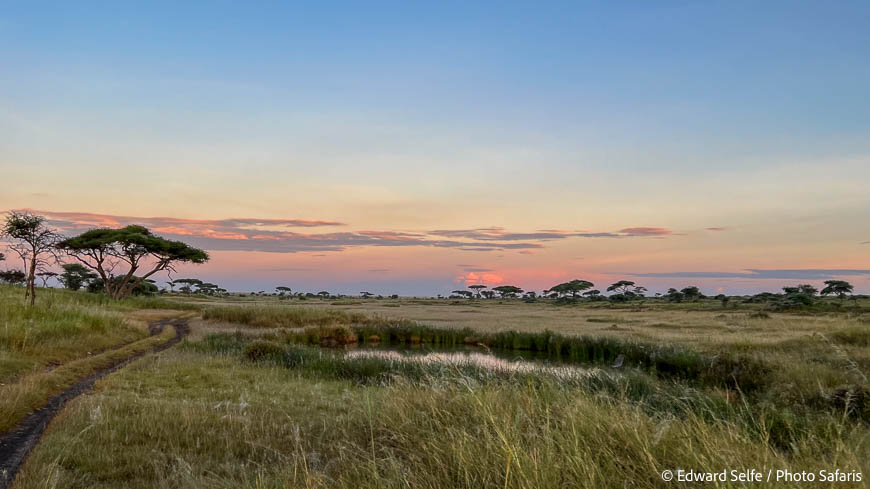
Setting out early again the next day. We were very much on the hunt for serval which had eluded us to this point. Using the assistance of small birds in the grass, we located one but it scampered off quickly. Another was soon spotted but disappeared when these two male lions appeared on the scene, calling loudly and staking their claim to the area.

As we left the lions, we came across a 3rd serval! It was hard to believe that we had gone a week not seeing one and then found 3 in the space of 45 minutes. We spent a couple of hours with this female, watching as she hunted and trying to line up good angles in the long grass.

The often cloudy conditions in the Serengeti at this time of year worked in our favour; shooting towards the light, we could better isolate the subject from the grass, and illustrate that stunning profile.


Catching up with the lions in the fever tree forest later that morning.

Perhaps the best view over the plains of the whole trip….

That evening will be seared into my memory; in the distance, Partena (our guide) somehow spotted an aardwolf! I was astonished that he saw it and identified it at a range of nearly a kilometre. More astonishing was that it then foraged towards us for 10 minutes, getting closer until it was perhaps 80m from the vehicle. The wind was in our favour and it seemed focused on its foraging but this was astonishing for a famously shy creature.

We stayed with it, moving occasionally and waiting for its circuitous foraging behaviour to bring it back closer to us. And finally achieving a wonderful encounter alongside the vehicle close to dusk. The raised tail and crest are in response to noticing us for the first time after having its head down foraging!

Our last full day in the Serengeti…started as our first one had done, with the trio of male cheetahs. They were active and we hoped for a hunt but were equally pleased when they scaled some tall rocks!

It was raining, but the next hour was magic nonetheless, and the soft light probably helped to keep the contrast in check!

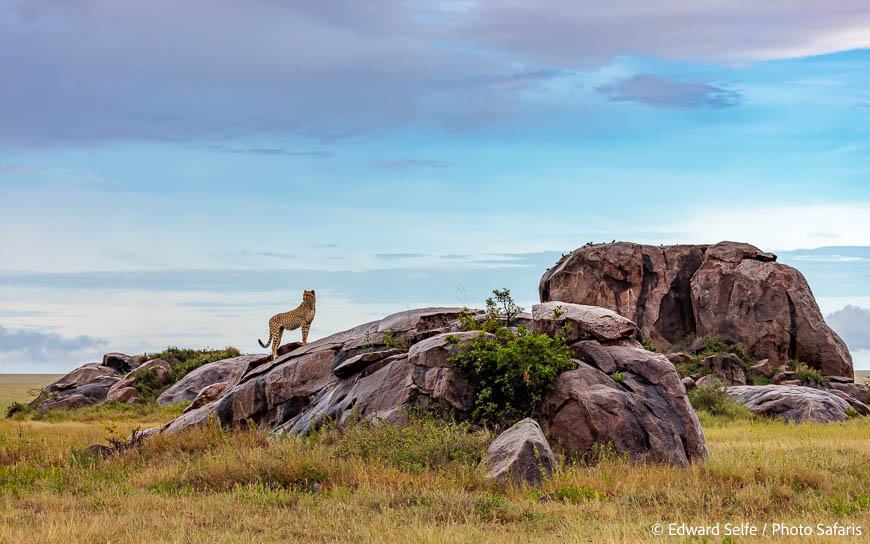
I love to make images where the subject is small in the frame, an element in its surroundings, but still the most eye-catching feature in the image. These cheetahs allowed us plentiful opportunities to achieve this.

Rainbows against the dark skies….

…and an epic sunset to end the final day!

My visit to the Ndutu and Serengeti areas had been a pleasure. As humans, we are always drawn to big spaces, large views and vast landscapes…the Serengeti has all of this plus extraordinary wildlife too. I enjoyed great company, an excellent guide in Partena and magical, private, serene and memorable experiences with Nature. As we woke on the last morning, and the camp was blessed with a full double rainbow, I reflected on how lucky we had been to enjoy the Serengeti all to ourselves, much as pioneer conservationists like Myles Turner did in the 1950s and 1960s. It was really a privilege and I hope to return and share this experience with future guests.
We stayed with Asilia Africa at Olakira Migration Camp and Namiri Plains. Partena, our guide, was superb and added all the local knowledge, expertise, patience and determination that makes for a classy experience. My guests, the Singh Family, were kind to share their experience and knowledge of this area (and of the wider ecosystem) and I am grateful to them all!




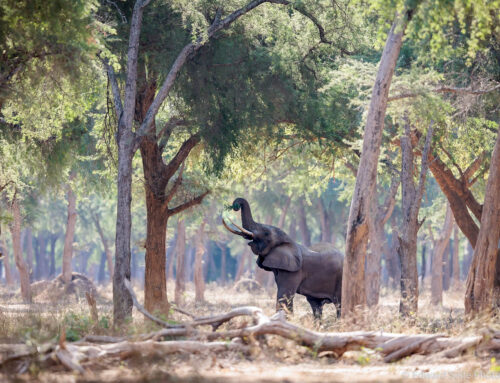
Leave A Comment